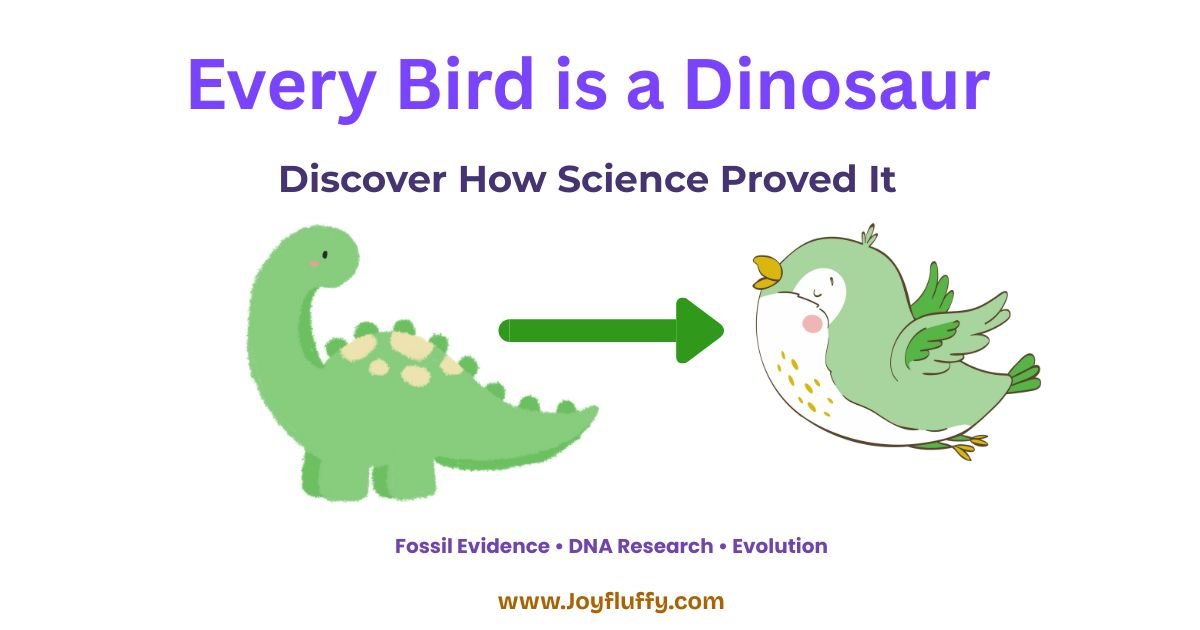Birds Are Living Dinosaurs: The Surprising Truth About Evolution
When you watch a robin hopping across your lawn or hear a crow cawing from a telephone wire, you are looking at something truly remarkable. These birds are not just distant relatives of dinosaurs. They are dinosaurs. This is not a metaphor or a simplified explanation for children. It is scientific fact based on decades of fossil evidence, genetic research, and careful study by paleontologists around the world.
The connection between birds and dinosaurs represents one of the most fascinating discoveries in modern science. Understanding this relationship changes how we see both the ancient past and the living world around us. Every time you spot a hummingbird or watch eagles soar overhead, you are witnessing the continuation of a lineage that survived the mass extinction event that wiped out nearly all other dinosaurs sixty-six million years ago.
The Scientific Discovery That Changed Everything
The story of understanding birds as living dinosaurs begins in the mid-1800s with a remarkable fossil discovery. In 1861, workers in a limestone quarry in Germany uncovered something extraordinary. The fossil showed clear impressions of feathers, yet the skeleton beneath those feathers looked remarkably like a small dinosaur. This creature, named Archaeopteryx, became the first clear link between dinosaurs and birds.
Archaeopteryx possessed a mix of features that seemed impossible. It had wings and feathers like a bird, but it also had teeth in its jaws, a long bony tail, and clawed fingers on its wings. These characteristics created immediate scientific debate. Was this creature a bird, a dinosaur, or something in between? The answer would take more than a century to fully understand.
Scientists now classify birds within the group Theropoda, the same group that includes Tyrannosaurus rex and Velociraptor. This means that taxonomically speaking, birds are not just related to dinosaurs. They are dinosaurs.
The breakthrough in understanding came in the 1960s when paleontologist John Ostrom studied a dinosaur called Deinonychus. This predatory dinosaur showed many bird-like features, including a light build, long arms, and a distinctive wishbone. Ostrom proposed that birds evolved from small carnivorous dinosaurs, a theory that was controversial at the time but has since been confirmed by overwhelming evidence.
The Fossil Evidence That Proves the Connection
Since the discovery of Archaeopteryx, paleontologists have found hundreds of fossils that document the evolutionary transition from non-flying dinosaurs to modern birds. These fossils come primarily from China, where exceptional preservation conditions have captured details that normally decompose, including feathers, skin, and even colors.
This small dinosaur had four wings, with long feathers on both its arms and legs. It lived about 120 million years ago and shows an experimental phase in the evolution of flight. The fossil evidence suggests it could glide between trees in prehistoric forests.
Discovered in 1996, this dinosaur preserved the first evidence of feather-like structures on a non-bird dinosaur. The fuzzy coat covering its body was not used for flight but likely helped with insulation. Scientists have even determined its color pattern, with a striped tail similar to modern raccoons.
This massive predator weighed over a ton and stood taller than a human, yet it was covered in long, shaggy feathers. Its discovery proved that even large dinosaurs could have extensive feather coverage, challenging the old image of scaly reptilian dinosaurs.
These fossils and many others create a clear timeline showing how dinosaurs gradually developed the characteristics we associate with modern birds. The evolution was not a sudden transformation but a gradual process spanning millions of years.
Feathers Did Not Evolve for Flight
One of the most surprising discoveries in dinosaur research is that feathers appeared long before birds could fly. Many non-flying dinosaurs possessed feathers, which raises an important question: why did feathers evolve in the first place?
Scientists believe feathers originally served other purposes. The earliest feather-like structures were simple filaments that likely provided insulation, helping dinosaurs maintain their body temperature. As these structures became more complex, they took on additional roles. Colorful feathers could have been used for display to attract mates or intimidate rivals, similar to how peacocks use their elaborate tail feathers today.
Functions of Dinosaur Feathers
- Temperature Regulation: Keeping warm in cool climates or cool in hot environments through insulation and heat dissipation.
- Display and Communication: Bright colors and patterns for attracting mates or establishing territory.
- Egg Brooding: Covering eggs with feathered limbs to maintain proper temperature for development.
- Water Repellency: Keeping skin dry in wet environments, similar to how duck feathers repel water.
- Sensory Function: Detecting air movement and objects nearby through sensitive feather bases.
Only after feathers had evolved for these other purposes did some dinosaurs begin using them for flight. The transition to powered flight happened gradually. Early attempts likely involved gliding from tree to tree or using wing-assisted running to help escape predators or catch prey.
How Modern Birds Reveal Their Dinosaur Heritage
You do not need to visit a museum to see evidence of the dinosaur-bird connection. Living birds carry numerous features inherited directly from their dinosaur ancestors. Understanding these features helps us see birds in a completely new light.
Skeletal Structure
Bird skeletons show remarkable similarities to their dinosaur ancestors. The hollow bones that make flight possible first evolved in theropod dinosaurs for weight reduction. The unique arrangement of the wrist bones in birds matches the configuration found in dinosaurs like Velociraptor. Even the distinctive backward-facing pubic bone that gives birds their characteristic posture is inherited from theropod ancestors.
The wishbone, technically called the furcula, is often thought of as a bird feature. However, paleontologists have found wishbones in numerous non-bird dinosaurs. This fused collarbone provided flexibility and spring action for wing movement, and it served similar functions in the arms of predatory dinosaurs.
Respiratory System
Birds have one of the most efficient respiratory systems in the animal kingdom, with air sacs that allow continuous airflow through the lungs. This system enables sustained flight at high altitudes where oxygen is limited. Remarkably, fossil evidence shows that theropod dinosaurs possessed similar air sac systems. CT scans of dinosaur bones reveal cavities where air sacs once connected to the respiratory system.
Reproduction and Behavior
The way birds reproduce and care for their young also connects them to dinosaurs. Many dinosaurs built nests, sat on their eggs to incubate them, and likely cared for their hatchlings. Fossil evidence shows dinosaurs arranged their eggs in careful patterns, just as modern birds do. Some fossils even preserve parent dinosaurs sitting on nests in a position identical to brooding birds.
Research on dinosaur eggshells has revealed proteins that are nearly identical to those found in modern bird eggs. This molecular evidence provides another link confirming the evolutionary relationship between dinosaurs and birds.
Brain Structure and Intelligence
Modern birds, particularly corvids like crows and ravens, display remarkable intelligence. They use tools, solve complex problems, and demonstrate self-awareness. This intelligence has evolutionary roots in their dinosaur ancestors. Studies of dinosaur brain cavities show that many theropods had enlarged brain regions associated with coordination, problem-solving, and visual processing. These same brain regions are highly developed in modern birds.
The Extinction Event and Bird Survival
Sixty-six million years ago, an asteroid roughly six miles wide struck Earth near what is now Mexico. The impact released energy equivalent to billions of nuclear bombs, triggering global wildfires, tsunamis, and a prolonged period of darkness as dust and debris blocked sunlight. This catastrophic event, known as the Cretaceous-Paleogene extinction, killed about 75 percent of all species on Earth, including all non-avian dinosaurs.
Yet birds survived. Understanding why birds made it through when their dinosaur relatives perished helps explain how evolution works and why adaptability matters more than size or strength.
Several factors contributed to bird survival. Their small size meant they needed less food than large dinosaurs. Their ability to fly allowed them to cover great distances in search of resources. Many early birds likely had generalist diets, able to eat seeds, insects, or whatever food they could find. This flexibility proved crucial when normal food chains collapsed.
Recent research suggests that ground-dwelling birds with limited flight ability went extinct along with other dinosaurs. The birds that survived were strong fliers that could have lived in diverse habitats. After the extinction event, these survivors rapidly diversified to fill ecological niches left empty by extinct species.
What This Means for How We Think About Dinosaurs
Recognizing birds as living dinosaurs fundamentally changes our understanding of what dinosaurs were like. For over a century, popular culture portrayed dinosaurs as slow, cold-blooded reptiles. Modern science paints a very different picture.
Many dinosaurs were likely warm-blooded, or at least had metabolic rates between cold-blooded reptiles and warm-blooded mammals. Their feather coverage supports this conclusion, as feathers would be unnecessary for purely cold-blooded animals. Active, fast-moving behavior evident in fossil trackways also suggests elevated metabolic rates.
Dinosaurs were probably much more colorful than old illustrations suggested. Since we know many had feathers, and modern birds use feather coloration for display, it makes sense that dinosaurs also sported vibrant colors and patterns. Some fossils preserve enough detail that scientists can determine actual colors using techniques that analyze melanin pigments preserved in fossil feathers.
Scientists have determined that Anchiornis, a small feathered dinosaur from China, had a distinctive color pattern with a red crest on its head, black and white striped wings, and a gray body. This makes it one of the first extinct animals whose colors we can describe with confidence.
The vocal abilities of dinosaurs also come into question. If birds are dinosaurs and birds are among the most vocal animals on Earth, did non-avian dinosaurs sing or call? While we cannot know for certain, anatomical studies of dinosaur skulls suggest many species had complex airways that could have produced sounds. Some may have cooed like doves, others may have honked like geese, and larger species might have produced deep, resonant calls that carried for miles.
Birds as a Success Story of Evolution
With over 10,000 species living today, birds represent one of the most successful groups of vertebrates on Earth. They inhabit every continent, including Antarctica, and have adapted to virtually every environment from deserts to oceans to tropical rainforests.
This diversity stems from their dinosaurian heritage. The basic body plan inherited from theropod ancestors proved remarkably adaptable. Small changes in beak shape allow different species to specialize in different foods. Modifications to wing shape enable everything from the hovering flight of hummingbirds to the soaring of albatrosses. Changes in leg structure allow penguins to swim underwater while ostriches run at high speeds.
The evolutionary innovations that first appeared in dinosaurs continue to serve birds well today. The efficient respiratory system supports both high-altitude flight and the extreme exertion of migration. The lightweight skeleton allows flight while remaining strong enough to support muscle attachment. The specialized digestive system processes food quickly to maintain the high metabolism needed for flight.
Ongoing Research and New Discoveries
Our understanding of the dinosaur-bird connection continues to evolve as new fossils are discovered and new analytical techniques are developed. Each year brings remarkable findings that add detail to the picture of how birds evolved.
Recent discoveries have focused on understanding the origin of flight itself. Fossils of transitional species show experimental phases where dinosaurs tried different approaches to becoming airborne. Some had four wings, others had asymmetric feathers suggesting they were learning to maneuver in the air, and still others show features suggesting they were better gliders than powered fliers.
Advanced imaging techniques now allow scientists to study fossil feathers at the microscopic level, revealing details about structure and color. Computer modeling helps researchers understand how extinct species moved, what they could see and hear, and how they might have behaved. Genetic studies of modern birds provide insights into which traits are ancient, inherited from dinosaur ancestors, and which evolved more recently.
Modern Research Techniques
- CT Scanning: Reveals internal bone structures and air spaces without damaging precious fossils.
- Melanin Analysis: Determines colors of extinct animals by studying preserved pigment structures.
- Protein Sequencing: Recovers ancient proteins from fossils to understand evolutionary relationships.
- Computer Modeling: Simulates how extinct animals moved and tests biomechanical capabilities.
- Comparative Anatomy: Studies similarities between fossil species and living birds to understand function.
Why This Knowledge Matters
Understanding that birds are living dinosaurs is more than a scientific curiosity. This knowledge has practical implications for fields ranging from aviation to conservation.
Engineers study bird flight to design better aircraft and drones. The efficiency of bird wings and the way birds control their flight has inspired innovations in aerospace technology. Understanding how birds maintain stable flight in turbulent conditions helps create more stable flying machines.
Conservation efforts benefit from understanding evolutionary relationships. Knowing that birds represent a lineage that survived one of the worst mass extinctions in Earth history provides perspective on resilience and adaptation. It also reminds us that even successful lineages can face extinction when environmental changes occur too rapidly, making modern conservation efforts crucial.
The dinosaur-bird connection also provides excellent examples for teaching evolution. Unlike some evolutionary transitions that lack clear fossil evidence, the transition from non-avian dinosaurs to birds is one of the best-documented evolutionary sequences in the fossil record. This makes it valuable for education and for understanding how evolution actually works.
The next time you see a bird, take a moment to appreciate what you are really looking at. That sparrow at your bird feeder, that hawk circling overhead, that duck swimming in a pond—each one is a living dinosaur, carrying on a lineage that stretches back more than 150 million years. They survived when massive predators and gentle giants could not. They adapted when others went extinct. They represent not the end of the age of dinosaurs, but its continuation into the present day.
Birds prove that dinosaurs were not failures destined for extinction. They were successful, adaptable, and diverse animals that responded to environmental challenges through evolution. Some lineages ended, but one lineage found a way to persist by taking to the sky. In doing so, they transformed from terrestrial predators into the masters of flight we see today.
Science continues to reveal new details about this remarkable evolutionary story. Each fossil discovery adds another piece to the puzzle of how modern birds came to be. The story of birds and their dinosaur ancestry reminds us that life on Earth is constantly changing, adapting, and finding new ways to survive and thrive.
Understanding birds as living dinosaurs enriches our appreciation of nature. It connects the distant past to the present in a tangible way. It shows us that evolution is not just a historical process but an ongoing one. And it gives us a reason to protect birds and their habitats, knowing that we are preserving not just species that exist today, but living representatives of ancient lineages that have persisted through millions of years of Earth history.





2 Comments